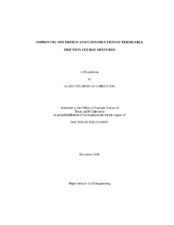| dc.contributor.advisor | Epps Martin, Amy | |
| dc.creator | Alvarez Lugo, Allex Eduardo | |
| dc.date.accessioned | 2012-02-14T22:17:49Z | |
| dc.date.accessioned | 2012-02-16T16:14:57Z | |
| dc.date.available | 2012-02-14T22:17:49Z | |
| dc.date.available | 2012-02-16T16:14:57Z | |
| dc.date.created | 2009-12 | |
| dc.date.issued | 2012-02-14 | |
| dc.date.submitted | December 2009 | |
| dc.identifier.uri | https://hdl.handle.net/1969.1/ETD-TAMU-2009-12-7321 | |
| dc.description.abstract | Permeable friction course (PFC), or new generation open-graded friction course (OGFC)
mixtures, are hot mix asphalt (HMA) characterized by high total air voids (AV) content
(minimum 18 %) as compared to the most commonly used dense-graded HMA. The high AV
content confers to PFC mixtures both high permeability and noise reduction effectiveness. These
characteristics and the high values of surface friction exhibited by PFC mixtures, as compared to
dense-graded HMA, lead to improvements in safety and the environment, which make PFC one
of the safest, cleanest, and quietest alternatives currently available for surface paving. The main
objective of this study was improving the current PFC mix design method and construction
practices in terms of compaction control.
Corresponding results were integrated in an improved mix design method that is based
on the guidelines of the current mix design method used by the Texas Department of
Transportation. The improved mix design included modified computation of the inputs required
to determine mixture density (or corresponding total AV content). These changes led to a
proposed modification of the density specification for mix design from 78-82 % to 76-80 %. In
addition, the water-accessible AV content was proposed as a surrogate of the total AV content
for mix design and evaluation. The improved mix design method also includes verification of
drainability, durability, and stone-on-stone contact. Computation of the expected value of
permeability (E[k]) and measurement of the water flow value were recommended, respectively,
for verification of drainability in the laboratory (using specimens compacted in the Superpave
Gyratory Compactor (SGC)) and in the field. The Cantabro loss test conducted in both dry- and
wet-conditions was suggested for assessing mixture durability. Improved criteria were proposed for verification of stone-on-stone contact based on the evaluation of the AV content in the coarse
aggregate fraction of the mixture. In addition, comparison of the internal structure of field-and
laboratory-compacted mixtures supported recommendation of a field-compaction control.
Recommendations to reduce the horizontal heterogeneity of AV encountered in PFC specimens
included using road cores with a minimum 152.4 mm diameter and coring SGC specimens from
152.4 to 101.6 mm in diameter | en |
| dc.format.mimetype | application/pdf | |
| dc.language.iso | en_US | |
| dc.subject | Permeable Friction Course | en |
| dc.subject | Open-Graded Friction Course | en |
| dc.subject | Mix Design | en |
| dc.subject | X-ray Computed Tomography | en |
| dc.subject | Permeability | en |
| dc.subject | Hot Mix Asphalt | en |
| dc.subject | Mixture Internal Structure | en |
| dc.title | IMPROVING MIX DESIGN AND CONSTRUCTION OF PERMEABLE FRICTION COURSE MIXTURES | en |
| dc.type | Thesis | en |
| thesis.degree.department | Civil Engineering | en |
| thesis.degree.discipline | Civil Engineering | en |
| thesis.degree.grantor | Texas A&M University | en |
| thesis.degree.name | Doctor of Philosophy | en |
| thesis.degree.level | Doctoral | en |
| dc.contributor.committeeMember | Lytton, Robert L. | |
| dc.contributor.committeeMember | Masad, Eyad | |
| dc.contributor.committeeMember | Glover, Charles | |
| dc.type.genre | thesis | en |
| dc.type.material | text | en |


